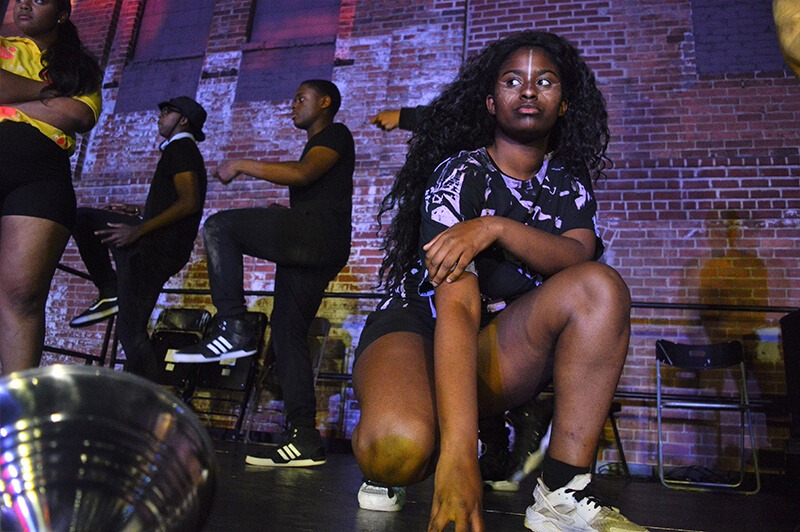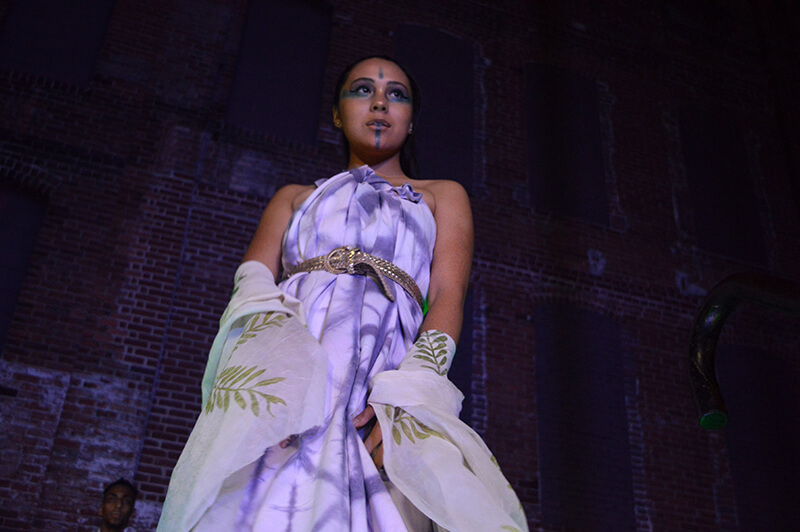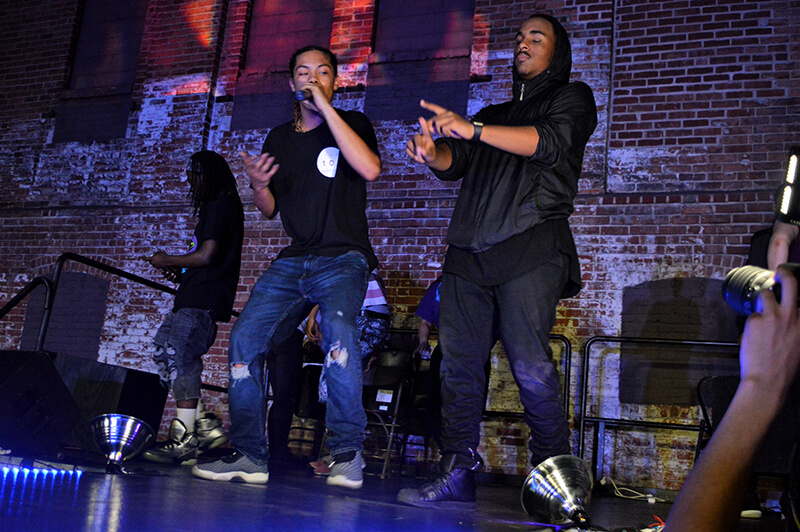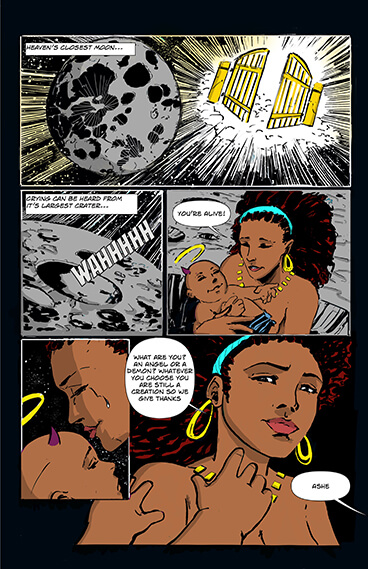Case Example
Building FUTUREWORLDS: AS220’s Youth-Led Movement to Design and Create the Futures we Want to Inhabit
Anjel Newmann and Seth Tourjee - AS220
This case example highlights FUTUREWORLDS, a large-scale, annual community event co-produced by AS220 youth and staff. The event blends elements of hip hop, Afrofuturism, art-making and social justice education to empower young people to re-imagine a more just and equitable world.

Photo by Diana Izaguirre, FUTUREWORLDS 2018
I tell my students at AS220 Youth that creation is an act of resistance and the creative process is an artist’s mechanism for self-liberation.
But if creation is an act of resistance then collective creation is an act of transformation. Alone, we may dream new worlds and even create parts of them, but collective creation allows collisions between individual ideas and visions, between people and their art, visions, beliefs and customs. These intersections and mergings result in growth, new frameworks and trajectories. After all, when five elements combined forces in a Bronx housing project playground, Hip Hop was born.
FUTUREWORLDS is a youth-led, multimedia learning pedagogy and production of AS220 Youth. It blends elements of hip hop, Afrofuturism, art-making and social justice education to empower young people to re-imagine a more just and equitable world.
The purpose of FUTUREWORLDS is to give young people the resources to co-create highly visible work that transforms the way we think about art, community and justice. We use our own remixed version of Stanford University’s Design Thinking model as a process to guide participation through each phase of a year-long curriculum, and hip hop, Afrofuturism/visionary fiction as a framework for content creation. FUTUREWORLDS culminates annually in the production of an interdisciplinary performance and art installation, presented to the public.
FUTUREWORLDS Over Time

Photo by Allam Mella, FUTUREWORLDS 2018
In 2013-14, AS220 Youth partnered with the Smithsonian’s Center for Folklife and Cultural Heritage to document fashion, style, and adornment in the African American community. This project, better known as Will To Adorn, was inspired by Zora Neale Hurston’s anthropology work in the South in the 1930’s, and brings together “culture bearers” who take swag to the level of high art. Thanks to the support from the Smithsonian’s Center for Folklife and Cultural Heritage, AS220 Youth was able to engage dozens of young people around the Will To Adorn project. Young people talked with members of the Hip Hop community about their own personal style and interviewed Cape Verdean grandparents about secret cultural recipes. Without a doubt, the highlight of 2014 was the Will To Adorn fashion show.
Our first fashion show went so well that young people demanded that we do another one. Through conversation with Kourtnie “Funmi” Alieru — Afrofuturist media artist, professor, and AS220 Youth alum — both staff and youth in our program began to ask these questions:
Why, when celebrating African-diasporic culture, do we only look to the past? What about the right now? What about the future? Are we in it? How are we represented?
These questions began to embed and even shape our studio classes. I laugh every time I think about the first few months that the word ‘Afrofuturism’ came up. “What the hell is afro blah blah blah” young people would ask. Not even the staff could quite grasp the verbiage or abstract theory associated with the genre.
The term ‘Afrofuturism’ was first articulated in 1993 by Mark Dery in his essay “Black to the Future.” He asked, “Can a community whose past has been deliberately rubbed out, and whose energies have subsequently been consumed by the search for legible traces in history, imagine possible futures?” While white, predominately male perspectives dominated science fiction and other genres in the U.S., Dery wrote, “African-American voices have other stories to tell about culture, technology, and things to come.”
Afrofuturism can be seen over many decades prior to and after Dery’s essay in the works of many artists of color, from the books of Octavia Butler to the sounds of Afrika Bambaataa and Sun Ra, to Beyonce’s “Lemonade” and the recent Black Panther film and new iterations of the comic books. Walidah Imarisha, writer, editor and intellectual, subsequently coined the term “visionary fiction” to further describe fiction that seeks to create just futures.
A core principle of AS220 Youth is that we strive to respond to the particular needs of the young people in our community. As a pedagogy, FUTUREWORLDS is intersectional and introduces participants to concepts of Afrofuturism and visionary fiction, while also providing a project and learning structure that allows them to make and present artwork that is actively engaging with issues that affect their lives. I have seen this process to be empowering and transformational for our youth, many of whom are of identities most impacted by systems of oppression: young people of color, LGBTQ, currently or formerly incarcerated, immigrants, in foster care, and those living in poverty.

Photo by Diana Izaguirre, FUTUREWORLDS 2018
Since that first fashion show in 2015, FUTUREWORLDS has taken place annually, further evolving each year — from fashion show to theatre production to interdisciplinary showcase to featured programming at PVDFest, a large city-wide arts and culture festival. Youth Apprentices and studio members have written, produced, and acted in full hip hop theater productions, created immersive art installations, designed and modeled innovative apparel, written and drawn comic books, performed and recorded original music, and organized pop-up marketplaces of youth-created artwork. Crucially, their Afrofuturist work is inspired and formed out of research, conversation, and collaborative thinking about social justice topics affecting our communities; topics include police brutality, systemic violence, education reform, immigration, food justice, addiction, and mass incarceration. Always, we guide youth to look to the future, to imagine solutions and then to create them.
Youth Leadership through Apprenticeship
On the ground, creating FUTUREWORLDS is no easy task. It takes a crew of professional artists, youth from across all of our four teaching sites, as well as time and careful planning to pull off a project of this scale. One of the most important aspects of FUTUREWORLDS is that it is youth-led. While program coordinators and staff introduce foundational learning materials and facilitate productive discussions, young people are the ones to drive the shape and content of each project. Our long-standing Youth Apprentice program focuses on providing the vision and leadership of the FUTUREWORLDS program.
Through an application and interview process, 25-30 paid apprentices are hired in the fall of each year by AS220 Youth staff. In August, we release applications, open to current youth members aged 16-21, and initiate the interview process. When considering youth for the Apprentice program, we ask ourselves the following questions “Is the applicant an active participant at AS220 Youth? Do they have or are they creating an artist portfolio? Are they involved with the Department Children Youth and Families (DCYF), formerly incarcerated or beyond risk in some way? Do they embody the values of AS220 Youth?” Youth who are invited in for an interview do not have to answer “yes” to all four of these questions, but the questions do help clarify who wants to be in the program and more importantly, who needs to be in the program. We do however mandate that at least 50% of the available positions go to DCYF involved youth, which includes youth in foster care and those who are formerly incarcerated. In August we also develop timelines, goals, roles for staff and a project strategy screen. The strategy screen is a set of criteria that both the larger production and smaller projects must satisfy. Criteria points incorporate the chosen social theme and elements of Afrofuturist pedagogy.
Apprentices choose one of our five crews — Digital Media, Music, Performance, Apparel, and Visual Art — and, through classes and mentorship, develop their skills within that medium while taking on leadership of their crew’s contribution to FUTUREWORLDS. Ultimately their goal is to develop their artistic practice, interpersonal and program leadership skills through workshop facilitation, and portfolio/project development. The Apprentice program builds career skills, fosters peership and collaboration between the students, and provides youth with close mentoring relationships with program staff.
Making FUTUREWORLDS
The creation of FUTUREWORLDS is structured by our own adapted phases of Design Thinking: Explore, Imagine, Prototype, Test and Reflect. The phases are nonlinear and each occurs multiple times throughout the year. In general however, we divide our calendar year by the phases:
September-October = Explore
November + December = Imagine
January – March = Prototype
April – June = Test
End of June = Reflect
On Mondays, all crews meet together. Through icebreakers, they build community by sharing their names, preferred pronouns and their opinion about a question posed by the facilitator. The facilitator normally chooses a prompt that is culturally relevant, exciting, and an on-ramp to the larger conversation or workshop discussion topic for the day.
For the remainder of our time together, each Monday a lesson of the week is introduced; a lesson that all crews will incorporate into their work as the week and overall production progresses. The 2018-19 edition of FUTUREWORLDS focused on addiction. During the fall of 2018, on Mondays, young people reflected on the following questions “What is a drug? What is addiction? Why are people poor?” Each question was followed by a series of activities that led them closer to many potential answers. Instructors and staff were deliberate about not giving youth the answers. The goal was to have them unpack the collective knowledge in the room by talking to one another, reflecting on personal experiences and thinking about what they’ve learned through family, friends, teachers and the media. Our angle with topics such as addiction is to move youth closer towards thinking systematically versus individual deficits or victim blaming.

Excerpted page from “Conceperous: A FUTUREWORLDS Story”, 2018
Throughout the year, Monday group discussions continued but there was an evident transition from mostly research to content creation. Youth artists spent the majority of their time in small, medium specific groups that were working to build their part of the theater production. The emcees wrote the scripts, apparel designed the costumes, digital media created music videos and abstract digitally projected backgrounds.
Once a week, all crews convened to share progress and clarify the week’s goals. During this time, the group also critiqued one another’s work and further identified how their crew’s artistic contribution fit into the larger production.
As we write this, FUTUREWORLDS nears, and the studio is full of tech rehearsals, last minute changes to scripts and loads of set design activities. While sometimes chaotic, the vibe of the studio feels not only productive, but purposeful and full of drive. Up until the show there’s still plenty of room for newcomers to jump in and help. It’s regular practice for staff to add in new dancers, visual artists, the message is clear — if you want to help, great! We need the help and we will find a way to fit you in, regardless of how close the show is. This practice embodies our belief that everyone has something meaningful to contribute.
FUTUREWORLDS is presented to the public annually, and in recent years has attracted hundreds of people. When the show is finally up on stage and the curtain closes, the young artists and the staff leave transformed. We are not the same people as when we entered. The feeling of accomplishing a project as big as FUTUREWORLDS massively shifts our expectations of each other and more importantly, ourselves. Our perspective of what is possible widens. Tears, hugs, and thank you’s are physical evidence of these changes. After one FUTUREWORLDS production, a young man came up to me with tears in his eyes and said, “I want to thank you for everything, you’ve given me a family.” I believe he said it best. After accomplishing FUTUREWORLDS, we are family, unified — a collective of individuals who now know what the power of community really looks like.